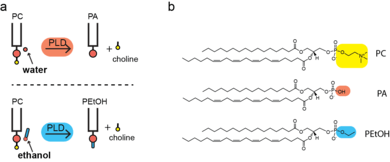Phosphatidylethanol
Phosphatidylethanols (PEth) are a group of phospholipids formed only in the presence of ethanol via the action of phospholipase D.[1] The lipid accumulates in the brain and competes at agonists sites of lipid-gated ion channels contributing to alcohol intoxication[2]. The chemical similarity of PEth to PA and PIP2 suggest a likely broad perturbation to lipid signaling, the exact role of PEth as a competitive lipid ligand has not been studied extensively.

Biological synthesis
When ethanol is present, PLD substitutes ethanol for water and covalently attaching the alcohol as the head group of the phospholipid; hence the name phosphatidylethanol. Normally PLD incorporates water to generate phosphatidic acid (PA); the process is termed transphosphatidylation.[3] PLD continues to generate PA in the presence of ethanol and while PEth is generated and the effects of ethanol transphosphatidlyation are through the generation of the unnatural lipid not depletion of PA.[4]

Marker in blood
Levels of phosphatidylethanols in blood are used as markers of previous alcohol consumption.[5][6] An increase of alcohol intake by ∼20 g ethanol/day will raise the PEth 16:0/18:1 concentration by ∼0.10 μmol/L, and vice versa if the alcohol consumption has decreased. However, it has been demonstrated that there can be significant inter-personal variation, leading to potential misclassification between moderate and heavy drinkers.[7] After cessation of alcohol intake, the half-life of PEth is between 4.5 and 10 days in the first week and between 5 and 12 days in the second week.[8] As a blood marker PEth is more sensitive than carbohydrate deficient transferrin (CDT), urinary ethyl glucuronide (EtG) and ethyl sulfate (EtS).[9]
Structure
Chemically, phosphatidylethanols are phospholipids carrying two fatty acid chains, which are variable in structure, and one phosphate ethyl ester.
References
- Gnann, H.; Engelmann, C.; Skopp, G.; Winkler, M.; Auwärter, V.; Dresen, S.; Ferreirós, N.; Wurst, F. M.; Weinmann, W. (2010). "Identification of 48 homologues of phosphatidylethanol in blood by LC-ESI-MS/MS". Analytical and Bioanalytical Chemistry. 396 (7): 2415–23. doi:10.1007/s00216-010-3458-5. PMID 20127079.
- Chung, HW; Petersen, EN; Cabanos, C; Murphy, KR; Pavel, MA; Hansen, AS; Ja, WW; Hansen, SB (18 January 2019). "A Molecular Target for an Alcohol Chain-Length Cutoff". Journal of Molecular Biology. 431 (2): 196–209. doi:10.1016/j.jmb.2018.11.028. PMC 6360937. PMID 30529033.
- Yang, SF; Freer, S; Benson, AA (10 February 1967). "Transphosphatidylation by phospholipase D.". The Journal of Biological Chemistry. 242 (3): 477–84. PMID 6022844.
- Chung, HW; Petersen, EN; Cabanos, C; Murphy, KR; Pavel, MA; Hansen, AS; Ja, WW; Hansen, SB (18 January 2019). "A Molecular Target for an Alcohol Chain-Length Cutoff". Journal of Molecular Biology. 431 (2): 196–209. doi:10.1016/j.jmb.2018.11.028. PMC 6360937. PMID 30529033.
- Hansson, Per; Caron, Murielle; Johnson, Goran; Gustavsson, Lena; Alling, Christer (1997). "Blood Phosphatidylethanol as a Marker of Alcohol Abuse: Levels in Alcoholic Males during Withdrawal". Alcoholism: Clinical and Experimental Research. 21: 108–110. doi:10.1111/j.1530-0277.1997.tb03736.x.
- Hansson, P; Varga, A; Krantz, P; Alling, C (2001). "Phosphatidylethanol in post-mortem blood as a marker of previous heavy drinking". International Journal of Legal Medicine. 115 (3): 158–61. doi:10.1007/s004140100206. PMID 11775018.
- Helander, Anders; Hermansson, Ulric; Beck, Olof (2019). "Dose–Response Characteristics of the Alcohol Biomarker Phosphatidylethanol (PEth)—A Study of Outpatients in Treatment for Reduced Drinking". Alcohol and Alcoholism. 54 (6): 567–573. doi:10.1093/alcalc/agz064. ISSN 0735-0414.
- Kechagias, Stergios; Dernroth, Dženeta Nezirević; Blomgren, Anders; Hansson, Therese; Isaksson, Anders; Walther, Lisa; Kronstrand, Robert; Kågedal, Bertil; Nystrom, Fredrik H. (2015). "Phosphatidylethanol Compared with Other Blood Tests as a Biomarker of Moderate Alcohol Consumption in Healthy Volunteers: A Prospective Randomized Study". Alcohol and Alcoholism. 50 (4): 399–406. doi:10.1093/alcalc/agv038. ISSN 0735-0414. PMID 25882743.
- Helander, A.; Peter, O.; Zheng, Y. (2012). "Monitoring of the Alcohol Biomarkers PEth, CDT and EtG/EtS in an Outpatient Treatment Setting". Alcohol and Alcoholism. 47 (5): 552–557. doi:10.1093/alcalc/ags065. ISSN 0735-0414. PMID 22691387.